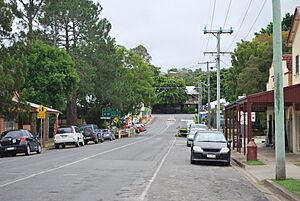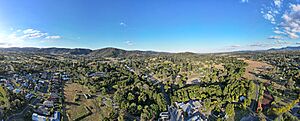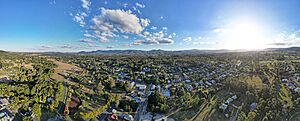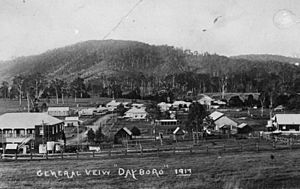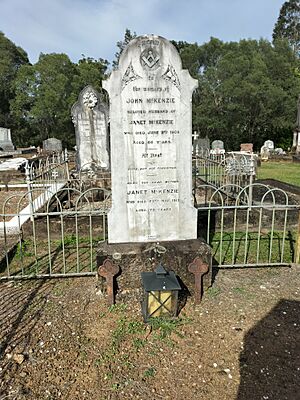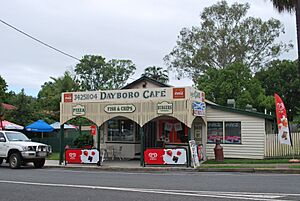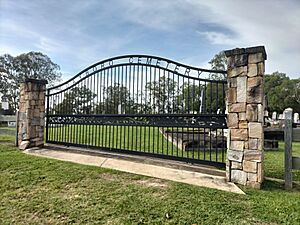Dayboro, Queensland facts for kids
Quick facts for kids DayboroQueensland |
|||||||||||||||
|---|---|---|---|---|---|---|---|---|---|---|---|---|---|---|---|
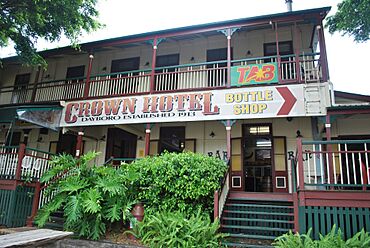
Crown Hotel
|
|||||||||||||||
| Population | 2,376 (2021 census) | ||||||||||||||
| • Density | 146.7/km2 (380/sq mi) | ||||||||||||||
| Postcode(s) | 4521 | ||||||||||||||
| Area | 16.2 km2 (6.3 sq mi) | ||||||||||||||
| Time zone | AEST (UTC+10:00) | ||||||||||||||
| Location |
|
||||||||||||||
| LGA(s) | City of Moreton Bay | ||||||||||||||
| County | County of Stanley | ||||||||||||||
| State electorate(s) | Pine Rivers | ||||||||||||||
| Federal Division(s) | Dickson | ||||||||||||||
|
|||||||||||||||
Dayboro is a lovely rural town in the City of Moreton Bay, Queensland, Australia. It's a great place to live or visit, with a population of 2,376 people recorded in the 2021 census.
Contents
Exploring Dayboro's Location
Dayboro is about 46 kilometers (29 miles) north-northwest of Brisbane, which is Queensland's capital city.
To the north, you'll find the D'Aguilar Range and the mountain town of Mount Mee. Other towns nearby include Petrie and Samford. The land around Dayboro is used for farming. You can see plantations of avocados and pineapples, and also farms with dairy cows.
Dayboro's Past: A Brief History
The area where Dayboro is located has a rich history. The Garumngar people, an Aboriginal group, have a language called Garumngar. Their traditional lands include this region.
How Dayboro Got Its Name
Dayboro has had a few different names over the years!
- It was first called Hamilton in 1875, named after a farmer named Hugh Hamilton.
- In 1892, it became known as Terrors Creek. This name came from a creek nearby. The creek got its name from a grey horse named Terah, owned by Captain John Griffin in the 1850s.
- Finally, in 1917, the name changed to Dayboro. This was to honor William Henry Day, an early settler who pioneered sugar growing in the area.
Early Schools and Churches
- Terror's Creek Provisional School opened on May 18, 1874. It later became Terror's Creek State School and then Dayboro State School in 1917.
- St Francis Xavier's Catholic Church opened on September 11, 1898.
- Terrors Creek Presbyterian Church was built in 1900. It later became Dayboro Uniting Church in 1977.
- St Aidan's Anglican Church officially opened on April 6, 1930.
Farming and Community Growth
Early settlers in the Terrors Creek area mainly farmed timber, maize (corn), vegetables, and dairy products. A store and a hotel opened in the early 1890s, followed by a sawmill around 1900 and a butter factory in 1903.
In 1915, Dayboro was described as a pretty town with a modern butter factory, a bank, stores, a hotel, a sawmill, and a public hall. The community was known for working together to improve their district.
The Dayboro Railway Line
On September 25, 1920, the Dayboro railway line opened. It connected Dayboro to Ferny Grove, passing through towns like Samford. This train line helped Dayboro for 35 years.
However, the railway closed on July 1, 1955. More people started using roads, so the train line wasn't needed as much. Today, parts of the old railway line can still be seen around Dayboro, like old bridges and cuttings.
Who Lives in Dayboro?
In the 2021 census, Dayboro had 2,376 people living there.
- Most people (82.4%) were born in Australia.
- Other countries of birth included England (8.4%) and New Zealand (2.1%).
- Almost everyone (96.2%) spoke only English at home.
Learning in Dayboro
Dayboro State School is a government primary school for students from Prep to Year 6. It's located at 58 McKenzie Street. In 2018, the school had 369 students. It also has a special education program to help students with different learning needs.
Places to Visit and Things to Do
Dayboro has many useful places for its community:
- The Moreton Bay City Council offers a mobile library service at Hay Cottage on William Street.
- The Dayboro branch of the Queensland Country Women's Association meets at the Moreton Bay City Council Building.
- You can find St Francis Xavier's Catholic Church at 135 McKenzie Street.
- St Aidan's Anglican Church is at 46-48 McKenzie Street.
- Dayboro Uniting Church is at 22 Williams Street.
- The Dayboro Cemetery is located where McKenzie Street, Riverview Court, and Laceys Creek Road meet.
- The Dayboro War Memorial Grounds at Don Kerr Memorial Drive have facilities for sports and community groups.
Exciting Events in Dayboro
Dayboro is known for its fun events throughout the year!
- The Dayboro Rodeo and Dayboro Show usually happen between May and July at the Showgrounds.
- The Dayboro Day Festival is held every year on the last Sunday in May. It started in 1991, and now over 20,000 visitors come to enjoy the entertainment, demonstrations, and market stalls. There's also an Antique & Collectables Fair!
- The Dayboro Country Markets are held on the first Sunday of every month, except in January.



